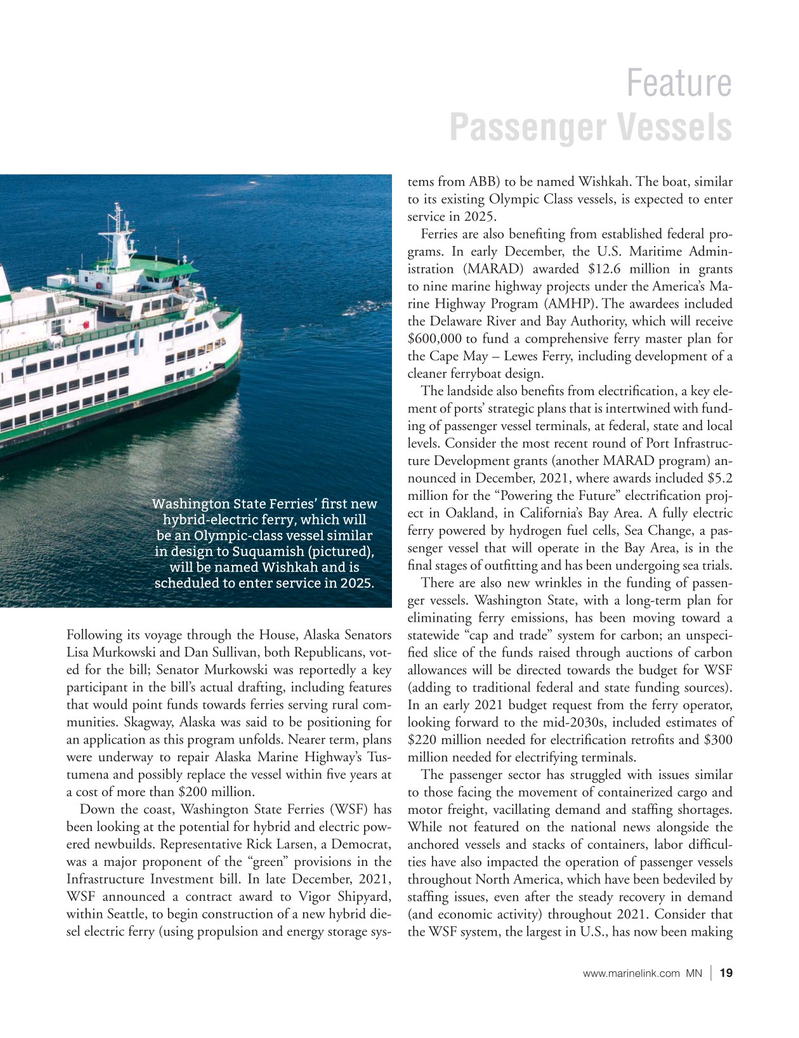
Page 19: of Marine News Magazine (January 2022)
Workboat Propulsion
Read this page in Pdf, Flash or Html5 edition of January 2022 Marine News Magazine
Feature
Passenger Vessels tems from ABB) to be named Wishkah. The boat, similar to its existing Olympic Class vessels, is expected to enter service in 2025.
Ferries are also bene? ting from established federal pro- grams. In early December, the U.S. Maritime Admin- istration (MARAD) awarded $12.6 million in grants to nine marine highway projects under the America’s Ma- rine Highway Program (AMHP). The awardees included the Delaware River and Bay Authority, which will receive $600,000 to fund a comprehensive ferry master plan for the Cape May – Lewes Ferry, including development of a cleaner ferryboat design.
The landside also bene? ts from electri? cation, a key ele- ment of ports’ strategic plans that is intertwined with fund- ing of passenger vessel terminals, at federal, state and local levels. Consider the most recent round of Port Infrastruc- ture Development grants (another MARAD program) an- nounced in December, 2021, where awards included $5.2 million for the “Powering the Future” electri? cation proj-
Washington State Ferries’ ? rst new ect in Oakland, in California’s Bay Area. A fully electric hybrid-electric ferry, which will ferry powered by hydrogen fuel cells, Sea Change, a pas- be an Olympic-class vessel similar senger vessel that will operate in the Bay Area, is in the in design to Suquamish (pictured), ? nal stages of out? tting and has been undergoing sea trials.
will be named Wishkah and is
There are also new wrinkles in the funding of passen- scheduled to enter service in 2025. ger vessels. Washington State, with a long-term plan for eliminating ferry emissions, has been moving toward a
Following its voyage through the House, Alaska Senators statewide “cap and trade” system for carbon; an unspeci-
Lisa Murkowski and Dan Sullivan, both Republicans, vot- ? ed slice of the funds raised through auctions of carbon ed for the bill; Senator Murkowski was reportedly a key allowances will be directed towards the budget for WSF participant in the bill’s actual drafting, including features (adding to traditional federal and state funding sources). that would point funds towards ferries serving rural com- In an early 2021 budget request from the ferry operator, munities. Skagway, Alaska was said to be positioning for looking forward to the mid-2030s, included estimates of an application as this program unfolds. Nearer term, plans $220 million needed for electri? cation retro? ts and $300 were underway to repair Alaska Marine Highway’s Tus- million needed for electrifying terminals. tumena and possibly replace the vessel within ? ve years at The passenger sector has struggled with issues similar a cost of more than $200 million. to those facing the movement of containerized cargo and
Down the coast, Washington State Ferries (WSF) has motor freight, vacillating demand and staf? ng shortages. been looking at the potential for hybrid and electric pow- While not featured on the national news alongside the ered newbuilds. Representative Rick Larsen, a Democrat, anchored vessels and stacks of containers, labor dif? cul- was a major proponent of the “green” provisions in the ties have also impacted the operation of passenger vessels
Infrastructure Investment bill. In late December, 2021, throughout North America, which have been bedeviled by
WSF announced a contract award to Vigor Shipyard, staf? ng issues, even after the steady recovery in demand within Seattle, to begin construction of a new hybrid die- (and economic activity) throughout 2021. Consider that sel electric ferry (using propulsion and energy storage sys- the WSF system, the largest in U.S., has now been making www.marinelink.com MN 19|

 18
18

 20
20
